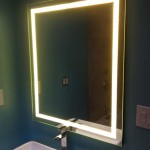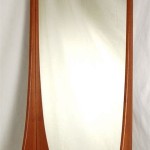Can You Hang A Heavy Mirror With Command Strips? A Comprehensive Guide
The question of whether Command Strips can be reliably used to hang heavy mirrors is a common one for renters and homeowners alike. The allure of avoiding nail holes and potential wall damage makes Command Strips an attractive alternative to traditional hanging methods. However, the suitability of Command Strips for this application hinges on a number of factors, primarily the weight of the mirror, the type of Command Strips being used, and the surface to which they are applied. This article provides a detailed exploration of these factors, offering a comprehensive guide to determining if Command Strips are a viable option for hanging heavy mirrors safely and effectively.
Command Strips are adhesive strips engineered to provide a temporary, damage-free hanging solution. They consist of two interlocking strips covered with a pressure-sensitive adhesive on both sides. One strip adheres to the item to be hung (in this case, the mirror), while the other adheres to the wall. When properly applied, these strips create a strong bond capable of supporting a certain amount of weight. The weight-bearing capacity is a primary consideration when assessing their appropriateness for hanging heavy mirrors.
The safety of using Command Strips for hanging mirrors is of paramount importance. If the strips fail, the mirror could fall, potentially causing damage to the mirror itself, the wall, or any objects or individuals in its path. Therefore, a thorough assessment of the risks and benefits is essential before proceeding. The following sections delve into the crucial aspects to consider when evaluating the feasibility of using Command Strips for this purpose.
Understanding Command Strip Weight Limits and Specifications
The first and most critical step in determining whether Command Strips are suitable for hanging a heavy mirror is to understand their weight limitations. Command Strips are not a one-size-fits-all solution; they come in various sizes and strengths, each designed to hold a specific maximum weight. This information is clearly indicated on the product packaging and should be carefully examined. It is imperative to select Command Strips that are rated to hold the weight of the mirror with a significant margin of safety.
It is strongly recommended to use multiple strips, even if the mirror's weight falls within the listed capacity of a single strip. Using multiple strips distributes the weight more evenly across the wall surface, reducing the strain on any single point of adhesion. For example, if a mirror weighs 8 pounds and the Command Strips are rated to hold 4 pounds each, using three or four strips, properly spaced, provides a much more secure and stable hanging solution than relying on just two. Refer specifically to the product packaging, in most cases, Command Strips provide weight allowance information per strip.
Moreover, it is crucial to consider the dimensions of the mirror. Larger mirrors present a greater surface area subject to forces such as gravity and vibrations. Even if the weight is within the Command Strips' capacity, the sheer size of the mirror can create leverage that could compromise the adhesive bond over time. In such cases, it may be necessary to opt for even stronger Command Strips or explore alternative hanging methods altogether.
When selecting Command Strips, pay close attention to the specific type. Some are designed for picture hanging and may not be suitable for the weight or type of backing found on mirrors. Look for Command Strips explicitly labeled for heavier items or those designed for use on smooth, non-porous surfaces, as these are more likely to provide a secure hold for a mirror.
Assessing Wall Surface Compatibility and Preparation
The type and condition of the wall surface play a crucial role in the effectiveness of Command Strips. Command Strips adhere best to smooth, non-porous surfaces, such as painted drywall, glass, tile, and metal. Textured walls, wallpapered walls, and walls with loose or peeling paint are not ideal candidates for Command Strips, as the adhesive may not be able to form a strong bond. The rough texture of such surfaces reduces the contact area between the strip and the wall, weakening the overall hold.
Proper wall preparation is essential, regardless of the surface type. Before applying Command Strips, thoroughly clean the wall surface with isopropyl alcohol to remove any dust, dirt, grease, or other contaminants. These contaminants can interfere with the adhesive bond, causing the strips to fail prematurely. Allow the alcohol to dry completely before applying the strips.
For newly painted walls, it is crucial to wait at least seven days before applying Command Strips. This allows the paint to fully cure and harden, ensuring a better bond. Applying Command Strips to uncured paint can damage the finish and compromise the adhesive's effectiveness.
Consider the environmental conditions of the room. High humidity and extreme temperatures can affect the adhesive properties of Command Strips. In bathrooms or kitchens, where humidity levels are typically higher, it may be necessary to use Command Strips specifically designed for moisture resistance. Similarly, in areas with extreme temperature fluctuations, the adhesive bond may weaken over time.
It is important to note that even with proper preparation, Command Strips may not be suitable for all wall surfaces. For example, walls with a heavily textured finish or those covered in delicate wallpaper should be avoided, as the Command Strips may damage the surface during removal.
Proper Application and Long-Term Monitoring of Command Strips
The correct application of Command Strips is critical to their success in hanging heavy mirrors. Follow the instructions provided on the product packaging carefully. Typically, this involves separating the strips, attaching one strip to the back of the mirror and the other to the wall, and then pressing them firmly together for a specified amount of time (usually 30 seconds). It is important to apply even pressure across the entire surface of each strip to ensure a strong and consistent bond.
Allow the adhesive to cure for the recommended time period, usually one hour, before hanging the mirror. This curing period allows the adhesive to fully bond to both the mirror and the wall, maximizing its holding power. Avoid disturbing the mirror during this time to prevent premature failure.
After hanging the mirror, regularly monitor the Command Strips for any signs of loosening or slippage. Check the bond between the strips and both the mirror and the wall. If you notice any movement or separation, immediately remove the mirror and replace the Command Strips. Ignoring these warning signs can lead to the mirror falling and causing damage.
The longevity of Command Strips can vary depending on several factors, including the weight of the mirror, the type of wall surface, and the environmental conditions. It is generally recommended to replace Command Strips every year or two, even if they appear to be holding strong. This proactive approach can help prevent unexpected failures due to gradual degradation of the adhesive.
When removing Command Strips, follow the instructions on the packaging to avoid damaging the wall surface. Typically, this involves gently pulling down on the strip, parallel to the wall, to release the adhesive. Avoid pulling the strip outwards, as this can tear the paint or wallpaper. If the strip breaks or leaves residue, use a plastic scraper or adhesive remover to carefully remove any remaining adhesive. Should damage occur, appropriate repair methods should be taken to restore the wall.
In summary, while Command Strips can be a convenient option for hanging lightweight items, their suitability for hanging heavy mirrors is contingent upon a careful assessment of weight limits, wall surface compatibility, and proper application and monitoring. Prioritizing safety and following the manufacturer's instructions diligently are essential. If there is any doubt about the Command Strips' ability to support the weight of the mirror securely, alternative hanging methods, such as using nails or screws anchored into wall studs, should be considered to ensure a reliable and long-lasting result.

Using Command Strips For Hanging A Mirror The Morris Mansion

Using Command Strips For Hanging A Mirror The Morris Mansion

Using Command Strips For Hanging A Mirror The Morris Mansion

How To Hang Heavy Mirrors Frames Without Nails 3m

Can You Hang A Mirror With Command Strips Hanging Heavy Decorative Bathroom Mirrors

How To Hang Heavy Mirrors Frames Without Nails 3m

Use 3m Command Strips To Hang Mainstays 13 Inch X 49 Rectangle Mirror

Using Command Strips For Hanging A Mirror The Morris Mansion

Using Command Strips For Hanging A Mirror The Morris Mansion

Command 20 Lb Xl Heavyweight Picture Hangers Damage Free Hanging 4 Pairs Com








